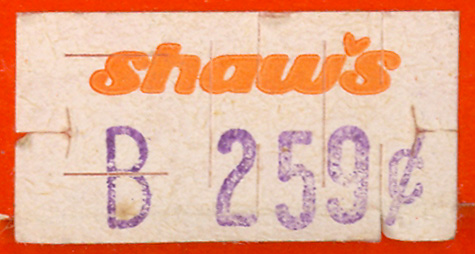If you do any grocery shopping in Massachusetts today, please be kind to the bewildered shoppers wandering the aisles looking lost and confused. Beginning today, stores in the Bay State no longer have to have price stickers on them.
Price stickers? What is this, the 1970’s?
No, but a law that finally reached its expiration date last night was a vestige of a bygone era, in which those newfangled bar codes and scanners were distrusted (read: “Happy 40th, Bar Code! You Don’t Look a Day Over 5-37000-00176”). Shoppers (and lawmakers) in states across the country wanted to see good old-fashioned price tags on every item, to ensure people knew exactly how much they were paying. Over time, one by one, laws mandating individual price tags faded away – Michigan did away with its version last year – and Massachusetts has just become the last to eliminate the price-tag requirement.
The new law doesn’t actually eliminate price tags altogether, but it allows stores to apply for a waiver with very specific requirements. They can remove price tags, if item prices are prominently marked on shelves (“with the price no smaller than one inch high”), if they install price scanners throughout the store, if their checkout system is shown to be at least 95% accurate, and if they agree not to lay off any employees whose job used to be to stick price tags on everything. If a customer ends up being overcharged, they’ll get the item for free if it’s worth less than $10, or a $10 gift card if it’s worth more. And the store can be fined up to $5,000.
Supporters, including the Retailers Association of Massachusetts, hailed the new law, saying that individual price tags were never all that accurate anyway. They cited a 2007 study that found higher rates of overcharges when price tags were mandated, resulting in prices that were “needlessly 10% higher when antiquated item pricing laws are in place.”
Those on the front lines are pleased about it, too. Employees will no longer have to change price tags on thousands of items every time the new sales circular comes out. When Michigan did away with its price-tag law, the Wall Street Journal spoke with a grocery store employee as he got down on his hands and knees to remove wadded-up old price stickers from the freezer case’s drain. “It’s a real pain in the you-know-what,” he said. A spokesperson for Massachusetts-based Big Y stores told the Springfield Republican newspaper that employees in charge of price tags will be shifted to more customer service-oriented jobs.
As for shoppers, many are ambivalent about the change. “I very seldom look at a price sticker,” one Wegmans shoppertold the Worcester Telegram & Gazette. “Once I put it in my cart, I already know the price.” Added another shopper, “I usually look for a price on the store shelf” anyway. Other shoppers are less enthused about the idea. Some grumble that once an item is in their cart, they have to go back to the shelf or find a scanner if they forget how much it was. “If I had to run back and forth with an item to see how much it’s going to cost, it would take me an awful long time to do my shopping,” one woman told WWLP-TV. “It’s going to be tough,” another shopper told the Telegram & Gazette. “You may not know what the price is until you get to the register. It really puts more responsibility on the consumer.”
Consumers in 49 other states have learned how to handle it. So what’s the worst that could happen in Massachusetts today? You could get overcharged and score a $10 gift card. Not a bad way to ring in the new year.
Image source: Neato Coolville















To the people that complain about having to run back and forth to the scanners, if you’re really that concerned about watching the prices, the law actually requires a minimum amount of scanners capable of printing labels with the price on them.
Does anyone know if the “free if item is under $10” policy applies whether or not the store is working under the waiver or not (needs to mark the price on the item or not)? Example would be that an item is marked on sale in the flyer & on shelf sticker but item rings up regular price, should that item be free or just the difference between sale & regular price?
Also is there a limit to the quantity? If I buy 3 of something & they all ring up wrong would all 3 be free or just one of the 3 & the others being the difference between sale & regular price?
And lastly can different stores have different policies on this law?
Thanks.
Hi Jon,
You can find the full text of the law here:
malegislature.gov/Laws/GeneralLaws/PartI/TitleXV/Chapter94/Section184C/
It says the rule applies no matter how the prices are displayed (item sticker or shelf price). If you buy multiples of the same item, you just get one free (up to a maximum of $10) and the correct price on the rest. Stores can have slightly different policies, in that they can give you a $10 gift card instead of $10 in cash if the item is more than that amount, but otherwise it doesn’t look like there’s a whole lot of wiggle room to do anything else differently.
Hope that helps!
I think it does. 🙂 I used to work at a grocery store in the late ’80’s-early ’90’s in New York and the free item deal was the policy we had back then. However it seems that when I go to the customer service counters around here for the past few years & bring up the difference they almost always just give me the difference between the 2 prices (I generally catch a wrong price at least once a month).
I may have to print this info out & bring it with me when I go grocery shopping!
Thanks again!